Last weekend, I raced my first Triathlon since 2019; I spent some time speaking with the race director; he was a fun guy.
He talked about how they were being asked by people racing their events to do more with their data. He said we need an app; I said probably not.
We talked about how they could compare their racer’s times to predict future results, help them find their closest competitors, and use this to make race recommendations!
Not bad for a post-race discussion.
It got me thinking about conversations I’d been having with Private Equity partners and some research we completed that you’ll probably get value from.
If you aren’t investing in Data Science, you can be sure your competitors are. Data science has fast become a differentiator in sourcing, dealing and value creation.
However, less than half of all PE firms have Data Science capabilities. Those that do are struggling to scale up their capability—both internally and within their portcos.
Can you afford not to focus on Data Science?
It would help if you created ‘innovation sandboxes’ to make this process scale. This approach should reduce the reliance on tech leads to start building models. These should be templated technical implementations. You can use them to scale your capabilities across multiple portcos simultaneously. You can repeat this same process for your firm’s internal teams.
We’ve talked more about this in the report ‘Creating value when it comes to technology change for Private Equity Portfolio Companies.’
If you’d like a copy, please let me know; you can contact me at: thomas@themarkethill.com.
Keep leading; it matters.
Thomas

